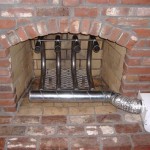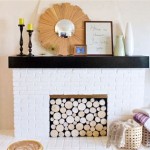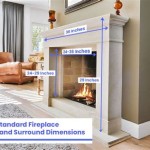Contemporary Fireplace Surround Designs: Form, Function, and Focal Point
The fireplace, long a symbol of warmth and gathering, has evolved significantly in its design and integration into modern living spaces. No longer confined to purely functional roles, the contemporary fireplace serves as a dynamic focal point, contributing significantly to the aesthetic appeal and ambiance of a room. The fireplace surround, in particular, plays a critical role in shaping the overall look and feel, bridging the gap between the functional firebox and the surrounding architecture. This article explores the diverse landscape of contemporary fireplace surround designs, examining key trends, materials, and considerations for achieving a harmonious blend of form and function.
Contemporary design sensibilities prioritize clean lines, minimalism, and a seamless integration with the existing architectural style. This translates to fireplace surrounds that often feature simple geometric shapes, a reduction in ornamentation, and a focus on highlighting the natural beauty of the chosen materials. The goal is to create a visually appealing feature that complements, rather than overwhelms, the surrounding space. Color palettes tend to be neutral, often incorporating whites, grays, and blacks, allowing the texture and form of the surround to take center stage. However, bold accents and pops of color are also employed to create visual interest and personalize the design.
The selection of materials is crucial in defining the character and impact of a contemporary fireplace surround. The choice extends far beyond traditional brick and wood, encompassing a wide range of options, each with its unique aesthetic properties and performance characteristics. Furthermore, sustainability considerations are increasingly influential, with many designers opting for eco-friendly materials like reclaimed wood, recycled glass, and sustainably sourced stone.
Minimalist Fireplace Surrounds: Embracing Simplicity
Minimalism, a dominant force in contemporary design, emphasizes simplicity, functionality, and the absence of unnecessary ornamentation. Minimalist fireplace surrounds reflect this philosophy, often featuring sleek, clean lines and a focus on the inherent beauty of the chosen material. These designs are typically characterized by a lack of elaborate details, ornate carvings, or decorative moldings. The emphasis is on creating a smooth, uninterrupted surface that seamlessly integrates with the surrounding wall and highlights the fire itself.
Materials commonly used in minimalist fireplace surrounds include concrete, large-format tiles, metal, and engineered stone. Concrete, with its inherent texture and industrial aesthetic, is a popular choice, lending a sense of solidity and understated elegance. Large-format tiles, particularly those with a matte finish, offer a similar aesthetic, providing a clean, seamless surface that minimizes grout lines. Metal, such as stainless steel or brushed aluminum, can add a touch of modernity and sophistication, while engineered stone provides a durable and low-maintenance option that mimics the look of natural stone. The color palette tends to be neutral, with whites, grays, and blacks dominating, allowing the form and texture of the surround to speak for themselves.
The incorporation of linear fireboxes is common in minimalist designs, further emphasizing the clean lines and geometric shapes. These fireboxes often feature a long, horizontal flame that is visually striking and complements the minimalist aesthetic. Integrated storage solutions, such as recessed shelves or hidden compartments, can also be incorporated to maintain a clutter-free environment and enhance the functionality of the fireplace area.
Lighting plays a crucial role in highlighting the minimalist design. Recessed lighting, strategically placed to illuminate the fireplace surround, can accentuate its texture and form, creating a warm and inviting ambiance. The absence of unnecessary decorations allows the fire itself to become the primary source of visual interest, drawing attention to its captivating dance and radiant warmth.
The Allure of Natural Stone in Contemporary Design
Natural stone has a timeless appeal, bringing a sense of authenticity, texture, and organic beauty to any design. In contemporary fireplace surrounds, natural stone is used in a variety of ways, ranging from rustic and rugged to sleek and refined. The key is to select the right type of stone and employ it in a way that complements the overall aesthetic of the space.
Popular choices for natural stone fireplace surrounds include marble, granite, slate, limestone, and travertine. Each stone possesses unique characteristics in terms of color, veining, texture, and density. Marble, with its elegant veining and polished surface, can add a touch of luxury and sophistication, while granite, with its durability and varied patterns, offers a more robust and visually dynamic option. Slate, with its dark, earthy tones and natural cleft texture, provides a rustic and grounding element, while limestone, with its soft, warm hues and porous texture, creates a sense of understated elegance. Travertine, with its characteristic pits and channels, adds a touch of Mediterranean charm and visual interest.
The size and shape of the stone also play a significant role in the overall design. Large-format stone slabs can create a seamless, monolithic appearance, while smaller, more textured stones can add visual interest and depth. The arrangement of the stone can also vary, from stacked stone walls to intricately patterned mosaics. The use of dry-stack stone, where the stones are fitted together without mortar, creates a rustic and natural look, while the use of mortar joints can provide a more refined and contemporary appearance.
Contemporary stone fireplace surrounds often incorporate a floating mantel, which adds a touch of visual lightness and prevents the design from feeling too heavy or grounded. The mantel can be made from wood, stone, or metal, depending on the desired aesthetic. The integration of lighting is also crucial in highlighting the natural beauty of the stone. Spotlights or recessed lighting can be used to accentuate the texture and color variations, creating a dramatic and visually appealing effect.
Material Mixing and Creative Textures: Adding Depth and Interest
Contemporary fireplace surround design often embraces the concept of material mixing, combining different materials to create visual interest and enhance the overall aesthetic. This approach allows designers to create unique and personalized designs that reflect the individual tastes and preferences of the homeowner. The key is to select materials that complement each other in terms of color, texture, and form, creating a harmonious and cohesive design.
Common material combinations include wood and stone, metal and wood, concrete and glass, and tile and brick. Wood and stone, a classic combination, provide a balance between warmth and texture, creating a visually appealing and inviting fireplace area. Metal and wood offer a more modern and industrial aesthetic, with the sleekness of the metal contrasting with the warmth and natural beauty of the wood. Concrete and glass create a minimalist and contemporary look, with the solidity of the concrete juxtaposed against the transparency and reflectivity of the glass. Tile and brick, a more traditional combination, can be updated with contemporary patterns and color palettes, creating a unique and personalized design.
Creative textures also play a significant role in adding depth and interest to contemporary fireplace surrounds. Textured panels, such as those made from reclaimed wood, metal, or sculpted concrete, can add a tactile and visually engaging element to the design. The use of different finishes, such as matte, glossy, or honed, can also create variations in texture and visual interest. The incorporation of three-dimensional elements, such as raised patterns or sculpted details, can add depth and dimension to the surround, creating a focal point that is both visually appealing and tactilely engaging.
The use of color is also crucial in achieving a harmonious and balanced design. Neutral color palettes, such as whites, grays, and blacks, provide a versatile backdrop for highlighting the textures and forms of the chosen materials. However, bold accents and pops of color can also be incorporated to create visual interest and personalize the design. The key is to use color strategically, ensuring that it complements the overall aesthetic and creates a cohesive and balanced look. The integration of lighting is also essential in highlighting the textures and colors of the materials. Spotlights and recessed lighting can be used to accentuate the details and create a dramatic and visually appealing effect.
Ultimately, the selection of materials, textures, and colors should be guided by the overall design aesthetic and the desired ambiance of the space. By carefully considering these factors, it is possible to create a contemporary fireplace surround that is both visually stunning and functionally efficient, serving as a focal point that enhances the beauty and comfort of the home.

24 Unique Fireplace Mantel Ideas Modern Designs

Best Modern Fireplace Designs Blaze

Contemporary Fireplace Surrounds And Mantels Ideas Direct Fireplaces

Contemporary Fireplace Surround Photos Ideas Houzz

7 Fireplace Surround Ideas That Will Ignite The Room

Top 5 Contemporary Fireplace Ideas In 2024 Studio

3 Best Modern Fireplace Mantel Decor Ideas Decorilla

Contemporary Fireplace Surrounds And Mantels Ideas Direct Fireplaces

7 Contemporary Fireplace Mantel Design Ideas For Interior Designers

Modern Ember Sabine Contemporary Wood Fireplace Mantel Surround Kit Black With 48 Inch Opening Minimal Design Clean Lines Aesthetic Com
Related Posts








